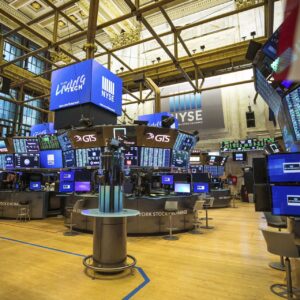Trump Tariff Threats Shake Market Confidence
Wall Street stumbled on Monday as Trump tariff threats returned to the headlines, unsettling markets that had just climbed to fresh record highs. The Dow Jones Industrial Average dropped 422 points, or 0.94%, while the S&P 500 lost 0.79%. The Nasdaq Composite shed 0.92% by the close. Though the final 15 minutes of trading saw modest buying, the session was risk-off.
President Trump reignited trade tensions with a series of letters to world leaders, warning that sweeping new tariffs between 25% and 40% would take effect by August 1 unless significant trade agreements are reached. Markets responded swiftly. Risk assets were hit the hardest, with the small-cap-heavy Russell 2000 plunging 1.6% amid growing concerns about economic growth.
“Regardless of the news, the market came into this week trading very extended,” said Justin Walters of Bespoke Investment Group. “With over 57% of S&P 500 stocks overbought, downside mean reversion was likely.” These remarks underscore the impact that Trump’s tariff threats can have when layered on top of already strained technical conditions.
The CBOE Volatility Index (VIX) spiked 9% to just under 18—still a far cry from its April highs above 60 when trade tensions first flared. Meanwhile, Treasury yields climbed, with the 2-year note reaching 3.9% and the 10-year yield touching 4.39%. Bonds were under pressure following Trump’s signing of his new tax bill while markets were closed for the holiday weekend.
According to Andrew Brenner of NatAlliance Securities, “We see more legacy spending than we would like, and the deficit going higher in the short term.” The bond market appears to be catching on, but full-on vigilantism hasn’t emerged—yet.
Low Volatility and Momentum Stocks Show Relative Strength
Despite the broad weakness, not all stocks fared equally. Utilities and other low-volatility sectors outperformed, with the Invesco S&P 500 ex-Rate Sensitive Low Volatility ETF among the top performers. Momentum ETFs also held up better, supported by the relative stability of names like Palantir Technologies.
Interestingly, Bitcoin remained resilient, down just 0.2% over the 24 hours, suggesting that crypto assets were not swept up in the same wave of risk aversion.
Outlook: Brace for August
Without major economic reports on the calendar this week, markets may remain vulnerable to headline-driven swings. If Trump tariff threats escalate, traders could see increased volatility across equity and bond markets. On the other hand, if negotiations progress and tariffs are delayed or canceled, stocks could rebound sharply.
For now, the market appears to be recalibrating from a position of overextension. The original July 9 tariff deadline has been delayed to August 1, and that date now looms large over global markets. As history has shown, if Trump’s tariff threats are reversed, the market has plenty of room to rally. But if they are enforced, the downside reaction could be just as powerful.
The path forward will largely depend on trade rhetoric emanating from Washington. Traders should prepare for more headline-driven volatility as the clock ticks toward August.
Key Index Summary: cnbc.com
-
S&P 500 (SPX): 6229.98 (▼49.37, -0.79%)
-
Dow Jones (DJIA): 44406.36 (▼422.17, -0.94%)
-
Nasdaq Composite (COMP): 20412.52 (▼188.59, -0.92%)

